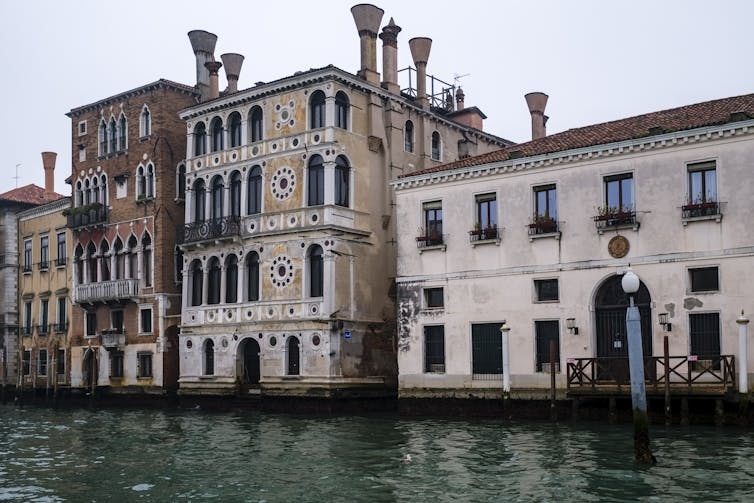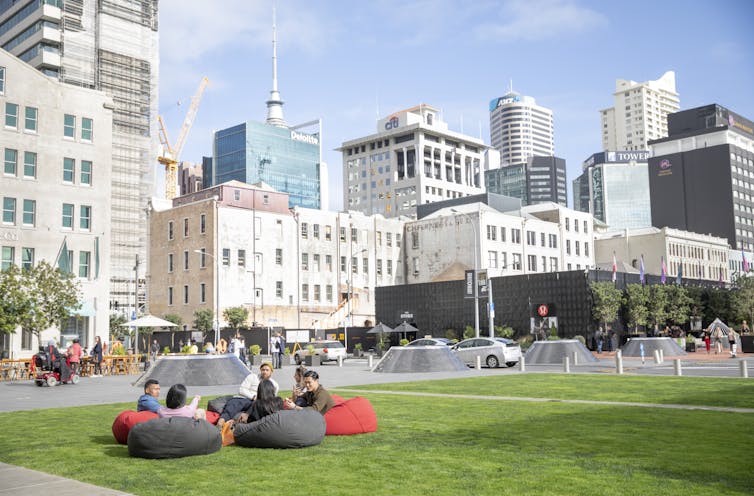By Jose Antonio Lara-Hernandez*
The COVID-19 pandemic and the hybrid work patterns it fostered have changed the way we think about office space, and central business districts in general. While fears of urban centre “ghost towns” may have been premature, many cities around the world still face dilemmas over how best to adapt.
New Zealand is feeling this pressure too. Office vacancy rates, while dropping slightly, have remained above 12%. At the same time, there is demand for high-quality, modern spaces that fit new work and collaboration models.
This isn’t an entirely new phenomenon. Throughout history, cities and buildings have been designed with specific functions in mind. As environmental and social needs change, however, these designs struggle to meet contemporary demands.
So, what can be done with the empty buildings and unleased floors scattered through cities everywhere? In our new book, Architectural Exaptation: When Function Follows Form, we examine the process by which existing structures or features are re-imagined and re-utilised.
In architecture, the concept of “exaptation” refers to this adapting of buildings and structures for new uses. It is becoming increasingly relevant as a transformative response to sustainable and resilient urban development.

The benefits of adapting
Exaptation in architecture requires us to view built environments not just as physical spaces, but as complex living systems that can adapt and transform.
Reusing and repurposing existing structures also helps reduce waste, CO₂ emissions and energy use, supporting more sustainable urban growth. At the same time, by reusing rather than rebuilding, the historical and cultural fabric of cities is preserved, as well as their inhabitants’ sense of identity.
A famous example is Venice, which has continuously adapted its historic structures to meet modern needs, while maintaining their unique character.
Sometimes seen as a static relic of the past, Venice is in fact a dynamic example of how urban spaces can evolve. The city’s ability to repurpose spaces and structures – turning palazzos into museums or residential buildings into boutique hotels – demonstrates architectural exaptation in practice.
The Highline in New York provides another good example. Rather than demolish an old elevated railway, it was repurposed as a pedestrian walkway, becoming a now iconic public space.

The social life of cities
The notion and application of architectural exaptation also has profound implications for the way we approach urban planning and development. In particular, it challenges the linear thinking and conventional growth models behind building new structures.

Encouraging the creative reuse of existing structures not only reduces resource use, it also embeds a layer of history and culture that enriches the urban experience.
The concept goes beyond the physical to encompass the social and cultural dimensions of city life. By fostering built environments that adapt to the needs of their communities, cities can become more inclusive and responsive to their inhabitants’ needs.
This also aligns with the idea of the “15-minute city”, which aims to fulfil the daily needs of residents within a short walk or bike ride – not unlike a medieval city or town, in that sense.
A paradigm shift
There are economic and logistical challenges with implementation, of course, including structural capacity. Some older buildings may require upgrades to meet required standards for their intended new function.
Building codes and regulations in some places are complex, which may not always align with the intended reuse. Moreover, depending on the infrastructure requirements of the new building’s use – power, plumbing, heating and ventilation systems – upgrades and compatibility work can be needed.
In some heritage buildings, the sensitivity of the architect in balancing preservation and modernisation becomes a key factor. And sometimes it is simply cheaper to build from scratch than to adapt.
But the main challenge is deeper still: encouraging a paradigm shift away from a conventional development model towards a more sustainable one.
To achieve that, building codes and regulations will need adjusting to be more flexible. Economic stimulus packages and financial and tax incentives will underpin any real shift to a new approach.

From Venice to Auckland
A city need not be as ancient and unique as Venice for this to work. Take Auckland, for example, where architectural exaptation could be applied to transform its moribund centre from a “dormitory” CBD into a vibrant and lively precinct.
Auckland’s remaining historic buildings have the potential for adaptive reuse and the incorporation of arts and culture into everyday spaces. This would foster a more dynamic environment, even after business hours. The Britomart precinct is a good example of this already happening.
More than that, given the challenges presented by climate change, architectural exaptation provides a blueprint for making cities more resilient, sustainable and flexible. This goes beyond architectural theory and is a call to action. It urges architects, planners and city dwellers to rethink the role of the built environment.
By learning from the adaptive strategies of the past, we can forge a future where our cities are not only sustainable, but also vibrant and culturally rich centres of human life.![]()
*Jose Antonio Lara-Hernandez, Senior Researcher in Architecture, Auckland University of Technology.
This article is republished from The Conversation under a Creative Commons license. Read the original article.
24 Comments
The answers to the question in title:
1. get realistic about rent expectations
2. reduce rent accordingly
3. renovate office spaces
4. welcome business tenants back
The Auckland CBD isn’t exactly a safe place to visit especially after dark.
I can’t see it ever returning to pre-Covid times when it was lively and vibrant.
Not with that attitude!
While I agree with you it isnt as nice as pre covid, its not unsafe. Go to any big city in the UK, Ireland, USA after dark and they have a much more unsafe feel than Auckland.
Agree. My teenage daughter and friends don't have any problems going in there at night and nor do I. I'm already tired of conservative nana's putting the boot in to NZ because of their need for bogeymen, and it's only been six months. What's next? Vigilante mobs?
Get local councils to use them, rather than them building new council offices for themselves, and putting up rates.
Wait for the return of the left wing govt, and these places will be turned into safe heavens for people on statewelfare, homeless and gangs.
Wait long enough for the current govt, and these places will be unoccupied tax-free capital gains for absentee owners.
I'd suggest that turning these office buildings into accommodation is not cheap and unlikely to achieve a reasonable ROI. I'm sure it been investigated and some empty office space is tolerated.
Agree. Have crutches numbers on this before and it’s very hard to make it work. NZ is a very expensive place to do anything.
Its just part of the purposeful wealth transfer. Land, compliance and council costs up a gazillion percent over the last 40 years. Who benefits? Owners. Old people.
Councils will also make it hard as converting office to living space generally means development levy CREDITS back to the developer, as the building is now being redesigned for 20 people per floor rather than 200. Removing load from the system. A good thing in many ways but council won't want to give up those tasty treats.
Current building owners to old to take a punt on anything other than capital gains or extortionate rent.
People who want to work and take a risk with their labour and skills told to go sit down.
Gosh, could you be more negative? Oh, and divisive?
I definitely think conversions are possible, and if the right people are involved from council and industry then there is opportunity in that space.
Won't happen because you'd be able to provide massive amounts of affordable housing and tank the housing market more so.
Although it speaks volumes about office design where people spend 10 hours a day and yet they are defined as difficult to inhabit from a living point of view.
My understanding is it's generally quite a bit more expensive to convert office builds to residential than it is to build brand new. Plus, you end up with awkwardly shaped flats and probably less efficient use of space. Not an expert myself, but that's what I've heard.
Good article, and agree that Auckland is a prime candidate. Unfortunately too many people (developers, councils, public) have trouble with unconventional thinking, even if it has actually been going on for hundreds of years without them noticing. Sevilla Cathedral and Hagia Sophia both magnificent examples of adaption to suit changing public requirements!
If rhe buildings can be sold cheap enough then appartment conversions have taken place on the past. Agree rents need to drop bit then the owners need less debt or less greed. Both things commercial owners don't seem to lack.
they must be watching international CRE and crapping themselves
100%. And having the bottom fall out of CRE may well make adaption to resi or other usage economic. Saw lots of this in Sydney in 90s
Watching International CRE and crapping themselves- That's for sure!
My son has been a Commercial Office Property Manager for 20 years. Became a specialist in Art Deco Skyscrapers in Chicago, and then was recruited in 2018 to manage an 1889 ten story Office Building just purchased by a Chicago group for $18 million. At the time it was the tallest building west of Chicago all the way to the West Coast. Within a year he had occupancy running at 95%. Then Covid hit-and ground floor hospitality business were given a rent moratorium to keep them from folding. 3 years later and interest rates doubling at the 5 year rest period and the Owners handed the keys to the building back to the Hedge Fund investors carrying the Mortgage. Occupancy in the office floors above down to 50% and no sign of recovery. Conversion to Apartments would suit, but totally uneconomic. Like Auckland city life is not dead and dangerous. Last place the suburban people wish to visit for hospitality at night is the once vibrant CBD of Minneapolis. Social workers have been sent out to do one on ones with Homeless People, but 90% don't want to be controlled in a safe place that has rules at night. And so my son has gone from the smartest guy in the family for picking a career that was as stable as a statue, to one full of worries and no sign on the horizon of getting better. Sister City St Paul just had their no 1 commercial landlord put 10 CBD buildings on the market-most Heritage Buildings, and with an average of only 50% occupancy. Deceased Estate Sale-should be interesting. Meanwhile taxpayers are bracing for the impact of greatly diminished Property Taxes which will need to be made up by residential rates increases.
Would we consider a derelict/vacant building tax? If people really want to sit on real estate instead of using it, they should pay for that luxury.
freeing up more spaces might reduce rents a bit too. Win win.
Whack on a congestion charge and make it near impossible to drive to your building. That'll fix it.
They've just sold off the Downtown car park too. So heaps less car parks. Guess everyone will have to bus or train in, how convenient for them.
One word, tax.
If you convert from commercial to resi, you need to pay GST as commercial is bought zero rated usually. So the deal really needs to be worth the pain you will go through with building regulations, codes, consents etc and a 15% kicker on the valye.
Conversion will occur as and when it is economic to do so.
At present council red tape, development contributions, high construction costs, high finance costs, high building values and low apartment values are preventing any conversions.
We welcome your comments below. If you are not already registered, please register to comment.
Remember we welcome robust, respectful and insightful debate. We don't welcome abusive or defamatory comments and will de-register those repeatedly making such comments. Our current comment policy is here.